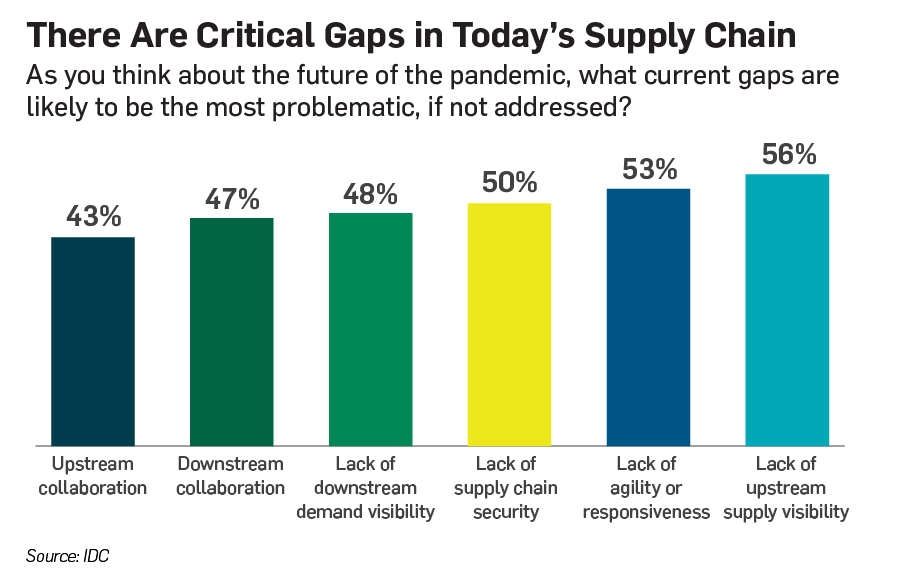Table of contents
Key Takeaways
-
The end-to-end pharmaceutical supply chain is suffering from a lack of upstream and downstream visibility.
-
Visibility, agility, and responsiveness are the three key components of supply chain resilience.
-
The first step toward achieving resilience is getting top-down support and changing the way your organization thinks about supply chains.
More than half of companies across the end-to-end pharma supply chain lack the upstream and downstream visibility needed to respond effectively to sudden marketplace disruptions, according to new research from market intelligence firm IDC into the impact of COVID-19 on the global pharmaceutical industry.
Visibility problems threaten efforts to build more agile, responsive, and resilient supply chains that can withstand and quickly recover from disruptions like those caused by the COVID-19 pandemic, the research found. They’re also hampering efforts to make patient-centric supply chains a reality.
"Visibility and agility are critical components of overall resiliency,” said IDC Program Vice President and Supply Chain Strategies Practice Leader Simon Ellis, who presents the survey findings in a new TraceLink on-demand webinar. “You simply can't be a resilient supply chain if you don't have those kinds of things.”
IDC and TraceLink surveyed more than 500 pharma supply chain companies—including manufacturers, CMOs, wholesalers, and dispensers—and also found that, despite the persistent problems, many supply chain companies recognize the value of supply chain visibility and are undertaking efforts to improve it. These efforts include investments in multi-enterprise digital supply networks, business intelligence and analytics applications, and collaboration tools.
More than three quarters of the survey respondents—78%—believe that improved supply chain visibility would lead to significant benefits like a reduction in drug shortages and better patient access to medicines.
"Shortages aren't just your problem. They're everybody's problem," Ellis said. "It's a supply problem. It's a demand problem. It's a transportation problem. It's an inventory problem."

What else stands in the way of supply chain resilience?
Poor end-to-end visibility is just one of the “critical gaps” that is making true supply chain resiliency an elusive goal, according to Ellis. Additional problems plaguing the supply chain include:
- A lack of responsiveness between supply chain partners.
- A lack of supply chain security.
- A lack of shared data on downstream demand.
- Poor downstream collaboration.
- Poor upstream collaboration.
As a result of these gaps, resolving issues with upstream suppliers and downstream customers can be painfully slow when problems arise. Nearly half of survey respondents—45%—report that it takes more than 40 days on average days to resolve issues upstream trading partners. Just under a third of respondents—29%—report that it regularly takes more than 40 days to resolve issues with downstream partners.
“Forty days is completely unacceptable if you're going to be patient-centric,” Ellis said. “It's completely unacceptable if you're going to be resilient.”
An equation for supply chain success
The good news is that there are some steps companies can take today to improve supply chain visibility. For starters, supply chain leaders must evolve the mental model of “supply chain” to encompass the entire supply chain, not just next-in-line upstream or downstream trading partners, according to TraceLink Digital Transformation Strategist Roddy Martin, who co-hosted the survey results webinar.
“It's incumbent on the leaders to paint the picture of an end‑to‑end, patient‑centric supply chain,” Martin said.
IDC’s Ellis added that there is one critical equation to remember when undertaking efforts to increase resiliency and patient-centricity.
“Visibility plus agility plus responsiveness equals resiliency,” he said. “If you are focusing on these three things and you develop the kinds of internal capabilities you need, you will be a resilient supply chain.”
Download the IDC white paper “Supply Chain Agility in the Pharmaceutical Industry” to learn more.






